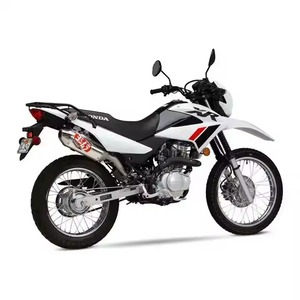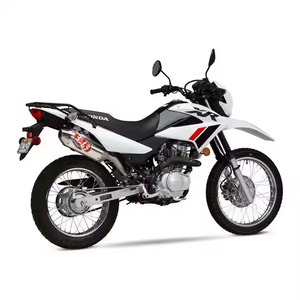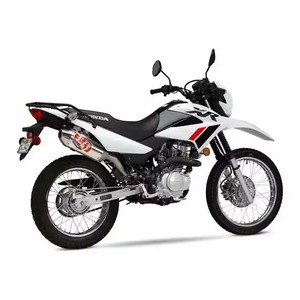Honda XR 150 Models Comparison
The Honda XR 150 comes in several variants, each designed with specific features to meet different riding needs. Understanding the differences between these models will help you choose the right bike for your requirements.
Honda XR 150L
A versatile dual-sport motorcycle engineered for both on-road commuting and off-road adventures. The XR 150L features:
- Reliable and fuel-efficient 150cc engine
- Long-travel suspension for varied terrains
- Comfortable ergonomic seat design
- Lightweight frame for enhanced maneuverability
- Street-legal lighting and instrumentation
Best for: Daily commuters who enjoy weekend trail riding
Honda XR 150BF
A rugged off-road focused variant built to handle challenging terrain with confidence. The XR 150BF offers:
- Powerful torque-optimized engine tuning
- Heavy-duty suspension components
- Aggressive tread pattern tires
- Reinforced frame construction
- Enhanced ground clearance
Best for: Dedicated off-road enthusiasts and rural terrain riders
Honda XR 150 Repsol
A special edition motorcycle with distinctive racing-inspired aesthetics and performance enhancements:
- Signature Repsol racing team color scheme
- Performance-tuned engine specifications
- Sport-oriented suspension settings
- Exclusive graphics and design elements
- Premium component finish quality
Best for: Enthusiasts seeking both performance and distinctive styling
| Feature | XR 150L | XR 150BF | XR 150 Repsol |
|---|---|---|---|
| Primary Use | Dual-sport (on/off-road) | Primarily off-road | Performance-oriented dual-sport |
| Suspension | Balanced for mixed use | Optimized for rough terrain | Sport-tuned for responsiveness |
| Aesthetics | Standard Honda styling | Rugged utilitarian design | Racing-inspired livery |
| Best For | Versatility and everyday use | Difficult terrain and durability | Performance and distinctive styling |
Rider Tip: When choosing between XR 150 models, consider your primary riding environment. The XR 150L offers the best balance for mixed riding conditions, while the BF excels in pure off-road situations. The Repsol edition adds visual appeal and performance refinements for those seeking something special.
Technical Specifications
The Honda XR 150 is renowned for its reliable engineering and balanced performance characteristics. Below are the detailed specifications that make this motorcycle a popular choice for versatile riding applications.
Engine
150cc air-cooled, four-stroke single-cylinder
Provides excellent power-to-weight ratio with proven reliability and efficiency across various conditions. The air-cooled design ensures simplicity and reduced maintenance needs.
Transmission
5-speed constant mesh
Offers smooth shifting and optimal gear ratios for both low-speed trail navigation and higher-speed road travel. The transmission is designed for durability in challenging environments.
Frame
Steel semi-double cradle frame
Engineered for strength and durability while maintaining appropriate flexibility for off-road absorption. The design prioritizes structural integrity in high-stress conditions.
Suspension
Front: Telescopic fork (35mm CRF design)
Rear: Twin shock with spring suspension
Provides excellent shock absorption and stability on uneven surfaces with responsive handling characteristics in varied terrain.
Brakes
Front and rear drum brakes
Delivers reliable stopping power with simplified maintenance requirements. The brake system is designed to perform consistently in both wet and dry conditions.
Tires
Front: 70/100-19
Rear: 100/100-18
All-terrain pattern provides excellent traction across diverse surfaces from pavement to mud, sand, and rocky paths.
Dimensions
Seat height: 845mm
Weight: Approximately 130 kg
The balanced dimensions ensure accessibility for riders of various heights while maintaining a lightweight profile for easy handling.
Fuel System
Tank capacity: 12 liters
Fuel efficiency: 40-45 km/liter
Provides excellent range for long-distance rides with economical consumption characteristics ideal for both recreational and utilitarian use.
Maintenance Schedule and Guidelines
Regular maintenance is crucial for ensuring the longevity, reliability, and optimal performance of your Honda XR 150. Following this comprehensive maintenance schedule will help you keep your motorcycle in peak condition.
Engine Oil
Replace with recommended 10W-40 or 10W-30 grade oil for optimal engine protection and performance.
Every 1,000 km or more frequently in harsh conditions
Air Filter
Clean thoroughly and inspect for damage. Replace if worn or damaged to prevent engine contamination.
Every 1,000 km (clean), more often in dusty environments
Valve Adjustment
Check and adjust intake/exhaust valve clearances according to specifications (typically 0.10mm intake, 0.12mm exhaust).
Every 5,000 km
Chain Maintenance
Clean, lubricate and adjust tension (25-35mm slack) to prevent premature wear and ensure smooth power delivery.
Every 1,000 km or after riding in wet conditions
Tire Inspection
Check pressure (Front: 25 psi, Rear: 28 psi), tread depth (minimum 3mm), and inspect for cuts or abnormal wear patterns.
Before each ride (pressure), weekly (condition)
Brake Maintenance
Inspect drum condition, adjust free play (10-20mm), and check brake shoes for wear (replace if thickness is less than 2mm).
Every 5,000 km
Suspension
Inspect for oil leaks, damage to fork seals, and check proper damping function by compression testing.
Every 5,000 km
Fuel System
Clean fuel filter, inspect fuel lines for cracks or deterioration, and check for proper carburetor operation.
Clean filter every 10,000 km
Electrical System
Test battery voltage (should be 12.5-12.8V), clean terminals, and check all lights and horn functionality.
Monthly
Spark Plug
Check condition and gap (0.7-0.8mm). Replace if electrodes show excessive wear or deposits.
Every 6,000 km
Clutch
Adjust free play (10-20mm) and inspect for smooth operation through entire engagement range.
Every 5,000 km
General Inspection
Comprehensive check of all fasteners, controls, cables, and overall condition.
Every 5,000 km
Maintenance Pro Tip: Keep a detailed maintenance log with dates, mileage, and services performed. This not only helps you stay on schedule but also increases resale value by demonstrating proper care. For off-road riders, consider more frequent service intervals as dust, mud, and water exposure accelerate wear on critical components.
Buyer's Guide: Selecting the Right Honda XR 150
Choosing the optimal Honda XR 150 for your specific needs requires careful consideration of several key factors. This comprehensive guide will help you make an informed decision when selecting your motorcycle.
Essential Selection Criteria
| Selection Factor | Considerations | Recommendation |
|---|---|---|
| Primary Riding Environment | Evaluate the terrain types you'll encounter most frequently (urban streets, highways, dirt trails, rough terrain) | XR 150L for mixed use, XR 150BF for predominantly off-road, Repsol for performance enthusiasts |
| Riding Experience | Consider your skill level and familiarity with motorcycle operation | Standard XR 150L for beginners, specialized variants for more experienced riders |
| Fuel Efficiency | Evaluate your need for economy and range between refueling | All models offer 40-45 km/l, but riding style significantly impacts actual efficiency |
| Maintenance Capabilities | Assess your mechanical skills and access to service facilities | Standard models typically require less specialized maintenance |
| Comfort Requirements | Consider rider height, weight, and ergonomic preferences | Test sit before purchase; aftermarket seat options available for customization |
| Budget Considerations | Factor in initial purchase price, insurance, maintenance costs, and accessories | Standard models offer best value; special editions command price premiums |
Additional Buying Considerations
- New vs. Used: Consider purchasing a used XR 150 with documented maintenance history to maximize value, especially for beginners. New bikes offer warranty protection and latest specifications.
- Dealer Reputation: Research dealer ratings for after-sales service quality and parts availability, which significantly affects ownership experience.
- Accessories Availability: Verify the availability of essential accessories like luggage racks, handguards, and protective equipment for your intended use.
- Resale Value: Standard models typically hold value better than special editions, though well-maintained special editions can appeal to collectors.
- Insurance Costs: Obtain insurance quotes before purchase, as rates can vary between different XR 150 variants.
Buyer's Tip: When possible, arrange for a test ride on different XR 150 variants to experience the subtle differences in handling characteristics. Many riders find that personal feel and comfort outweigh spec-sheet differences. Also, consider future needs – if you anticipate expanding your riding activities, choosing a more versatile model initially may save a future replacement.
DIY Maintenance and Parts Replacement Guide
The Honda XR 150 is designed with simplicity and accessibility in mind, making it an excellent platform for DIY maintenance and parts replacement. This comprehensive guide will help you successfully complete common maintenance tasks and parts replacements.
Preparation Essentials
- Source Genuine Parts - Use Honda genuine parts or quality aftermarket alternatives that meet OEM specifications for reliability and proper fit.
- Gather Required Tools - Prepare basic tools including socket set (8mm-19mm), screwdrivers (Phillips and flathead), pliers, torque wrench, and motorcycle-specific tools as needed.
- Obtain Service Manual - The official Honda XR 150 service manual provides essential specifications, torque values, and step-by-step procedures.
- Prepare Workspace - Establish a clean, well-lit work area with sufficient space to move around the motorcycle and organize parts and tools.
Safety Procedures
Safety First: Always disconnect the battery before working on electrical components. When working with fuel system components, ensure proper ventilation and eliminate ignition sources. Use appropriate safety gear including gloves and eye protection.
Common DIY Replacement Procedures
Oil & Filter Change
- Warm engine to operating temperature
- Remove drain bolt and allow oil to drain completely
- Replace drain bolt with new sealing washer
- Remove and replace oil filter
- Add 1 liter of 10W-40 oil
- Check level with dipstick, run engine briefly, recheck
Difficulty: Beginner
Air Filter Service
- Remove seat and side panels
- Locate and remove air box cover
- Extract filter element carefully
- Clean with air filter cleaner or replace
- Apply air filter oil if using foam element
- Reinstall correctly oriented filter and covers
Difficulty: Beginner
Chain Replacement
- Remove chain guard and master link
- Remove old chain from sprockets
- Check sprocket condition (replace if worn)
- Install new chain with manufacturer direction observed
- Secure master link with retaining clip facing opposite rotation direction
- Adjust tension (25-35mm slack)
Difficulty: Intermediate
Brake Shoe Replacement
- Remove wheel from motorcycle
- Disassemble brake panel from hub
- Note spring positions before removing
- Replace brake shoes, maintaining correct orientation
- Reinstall springs and assemble components
- Adjust brake free play (10-20mm)
Difficulty: Intermediate
Testing and Validation
After completing any replacement or maintenance procedure, it's essential to properly test the component before full operation:
- Perform static tests first (component movement, proper installation verification)
- Conduct controlled low-speed testing in a safe area
- Monitor for unusual noises, vibrations, or operational issues
- Make necessary adjustments before regular use
- Document all maintenance performed including date, mileage, and parts used
DIY Pro Tip: Take photos throughout the disassembly process, especially for more complex jobs. These visual references can be invaluable during reassembly. For beginners, start with simpler maintenance tasks and gradually progress to more complex procedures as you gain confidence and experience.
Frequently Asked Questions
The Honda XR 150 delivers excellent fuel efficiency, averaging 40-45 kilometers per liter (94-106 mpg) under normal riding conditions. This impressive economy makes it ideal for long-distance travel and daily commuting, significantly reducing operating costs. Actual fuel consumption may vary based on riding style, terrain conditions, maintenance status, and load weight.
The Honda XR 150 is available in three distinct colors: black, red, and blue. The standard models typically feature these classic Honda color schemes with matching graphics. The special Repsol edition showcases the distinctive orange, red, and black racing livery inspired by Honda's MotoGP racing team. Color availability may vary by region and model year.
The Honda XR 150 has a seat height of 865mm (34 inches), which is designed to provide good ground visibility while maintaining appropriate suspension travel for off-road capability. This seat height accommodates riders of various heights, though shorter riders may find it challenging to place both feet flat on the ground when stopped. Aftermarket lowering kits and custom seat options are available for riders seeking a lower seat position.
For optimal performance and longevity, Honda recommends following a regular service schedule for the XR 150:
- Basic inspection: Before each ride
- Oil change: Every 1,000 km or 3 months (whichever comes first)
- Air filter service: Every 1,000 km (more frequently in dusty conditions)
- Minor service (valve adjustment, carburetor check): Every 5,000 km
- Major service (including timing chain inspection): Every 10,000 km
Off-road riders should consider more frequent maintenance intervals due to the increased stress on components.
The Honda XR 150 has a top speed of approximately 110-120 km/h (68-75 mph) under ideal conditions with a standard rider weight. The motorcycle is optimized for mid-range torque rather than high-speed performance, making it excellent for trail riding and urban environments. Factors affecting maximum speed include rider weight, wind conditions, terrain, altitude, and motorcycle maintenance condition.





















































